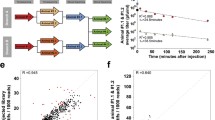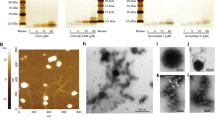Abstract
There is lack of a barrier between CSF and brain, thus peptide that can cross the blood–cerebrospinal-fluid barrier (BCSFB) will have a greater chance of providing access to the brain. In this study, we screened for a novel peptide sequence that can cross the BCSFB from the systemic circulation using phage display. We applied a 12-mer phage display peptide library (Ph.D.-12) intravenously in rats and recovered phage from the cerebrospinal fluid. A longer circulation time was used according to the biodistributive CSF/blood ratio of the phage particles. Following sequential rounds of isolation, several phages were sequenced, and a peptide sequence (TPSYDTYAAELR, referred to as the TPS peptide) was identified. Clone 12-1, which encoded the TPS peptide, was enriched approximately 53 times greater than the random library phage. After labeling with FITC, the TPS peptide demonstrated significantly greater brain accumulation efficiency. This study demonstrates the feasibility of using in vivo phage display to screen for peptides that can cross the BCSFB from the systemic circulation. In conclusion, the TPS peptide represents a previously unreported promising motif that can be used to design a drug delivery system that can cross the BCSFB.




Similar content being viewed by others
References
Abbott NJ, Patabendige AAK, Dolman DEM et al (2010) Structure and function of the blood–brain barrier. Neurobiol Dis 37:13–25
Arap W, Pasqualini R, Ruoslahti E (1988) Cancer treatment by targeted drug delivery to tumor vasculature in a mouse model. Science 279:377–380
Arap W, Haedicke W, Bernasconi M et al(2002)Targeting the prostate for destruction through a vascular address. Proc Natl Acad Sci 99:1527–31
Barry MA, Dower WJ, Johnston SA (1996) Toward cell-targeting gene therapy vectors: selection of cell-binding peptides from random peptide-presenting phage libraries. Nat Med 2:299–305
Begley DJ (2004) Delivery of therapeutic agents to the central nervous system: the problems and the possibilities. Pharmacol Thel 104:29–45
Cabilly S (1999) The basic structure of filamentous phage and its use in the display of combinatorial peptide libraries. Mol Biotechnol 12:143–148
Joyce JA, Laakkonen P, Bernasconi M et al (2003) Stage-specific vascular markers revealed by phage display in a mouse model of pancreatic islet tumorigenesis. Cancer Cell 4:393–401
Kehoe JW, Kay BK (2005) Filamentous phage display in the new millennium. Chem Rev 105:4056–4072
Kolonin MG, Sun J, Do KA et al (2006) Synchronous selection of homing peptides for multiple tissues by in vivo phage display. FASEB J 20:E99–E107
Lee JH, Engler JA, Collawn JF, Moore BA (2001) Receptor mediated uptake of peptides that bind the human transferrin receptor. Eur J Biochem 268:2004–2012
Lee TY, Wu HC, Tseng YL, Lin CT (2004) A novel peptide specifically binding to nasopharyngeal carcinoma for targeted drug delivery. Cancer Res 64:8002–8008
Li J, Feng L, Fan L et al (2011) Targeting the brain with PEG-PLGA nanoparticles modified with phage-displayed peptides. Biomaterials 32:4943–4950
Murai KK, Nguyen LN, Koolpe M et al (2003) Targeting the EphA4 receptor in the nervous system with biologically active peptides. Mol Cell Neurosci 24:1000–1011
Pande J, Szewczyk MM, Grover AK (2010) Phage display: concept, innovations and future. Biotechnol Adv 28:849–858
Pardridge WM (2007) Drug targeting to the brain. Pharm Res 24(9):1733–1744
Pasqualini R, Ruoslahti E (1996) Organ targeting in vivo using phage display peptide libraries. Nature 380:364–366
Pasqualini R, Koivunen E, Ruoslahti E (1997) Integrins as receptors for tumor targeting by circulating ligands. Nat Biotechnol 15:542–546
Pasqualini R, Koivunen E, Kain R et al (2000) Aminopeptidease N is a receptor for tumor-homing peptides and a target for inhibiting angiogenesis. Cancer Res 60:722–727
Praveen B, Alex B, Maiken N (2004) The blood–brain barrier: an overview: structure, regulation and clinical implications. Neurobiol Dis 16:1–13
Rooy IV, Tascioglu SC, Couraud PO et al (2010) Identification of peptide ligands for targeting to the blood–brain barrier. Pharm Res 27:673–682
Sidhu SS (2001) Engineering M13 for phage display. Biomol Eng 18:57–63
Smith GP (1985) Filamentous fusion phage: novel expression vectors that display cloned antigens on the virion surface. Science 228:1315–1317
Smith GP, Petrenko VA (1997) Phage display. Chem Rev 97:391–410
Wan XM, Chen YP, Xu WR et al (2009) Identification of nose-to-brain homing peptide through phage display. Peptides 30:343–350
Zou J, Dickerson MT, Owen NK et al (2004) Biodistribution of filamentous phage peptide libraries in mice. Mol Biol Rep 31:121–129
Acknowledgments
This work was supported by the Applied Basic Research Programs of Science and Technology Commission Foundation of Yunnan Province (2014FD044) and Foundation of Yunnan Educational Committee (2014Z136).
Conflict of interest
The authors declare that they have no conflict of interest.
Author information
Authors and Affiliations
Corresponding author
Rights and permissions
About this article
Cite this article
Li, J., Feng, L. & Jiang, X. In vivo phage display screen for peptide sequences that cross the blood–cerebrospinal-fluid barrier. Amino Acids 47, 401–405 (2015). https://doi.org/10.1007/s00726-014-1874-0
Received:
Accepted:
Published:
Issue Date:
DOI: https://doi.org/10.1007/s00726-014-1874-0




